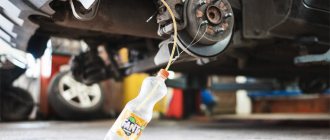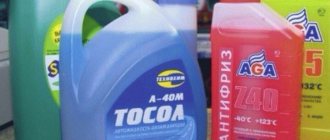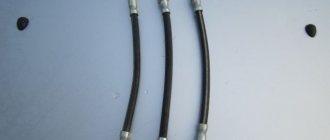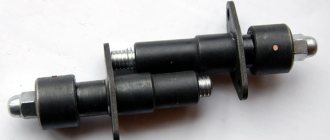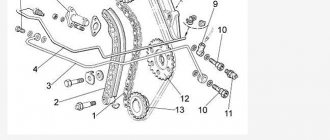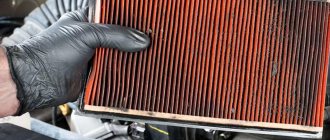Brake fluid is one of the most important service materials used in a car. The efficiency and reliability of the brakes directly depends on its quality.
Car manufacturers recommend changing brake fluid at certain intervals - usually once every two years (every 30-40 thousand kilometers). Such regulations were established as a result of many years of testing and calculations, so it is difficult to challenge them.
However, many drivers simply do not pay attention to the recommendations in the service book and do not pay due attention to the brake fluid - especially if no problems are observed in the operation of the brake system.
Let's see if those who do not consider it necessary to change the brake fluid on time are right. Let us name the signs of “aging” of the material and the rules for its independent replacement.
Why change brake fluid?
Brake fluid performs a specific function during the braking process. When the brake pedal is applied, it exerts pressure on the wheel cylinders from the GTZ. If there is a shortage of it in the system, the machine cannot be operated. And in the event of a leak, the brake cylinders on the wheels may not work at all.
Using old or low-quality fluid can lead to the following damage to your car:
| Malfunction | Cause | How to fix |
| Swelling of gaskets (pedal does not return to its original position) | Using a fluid of the wrong grade, containing sediment or mineral oils | Flushing the entire hydraulic drive system, replacing damaged sealing elements, replacing fluid, removing air from the system |
| The caliper piston is stuck (the pedal does not return to its original position) | Using old or poor quality fluid | Cleaning and bleeding of the entire hydraulic drive system |
| Presence of air in the brake system, wear of hoses (reduced effort when pressing the pedal) | Using old brake fluid with a high percentage of moisture | Removing air, replacing a hose, replacing brake fluid |
| Soft pedal, low braking efficiency | Using brake fluid with a low boiling point | Replacing brake fluid and removing air from the system |
Brake fluid freshly purchased from a store is incompressible. But due to the fact that it has increased hygroscopicity, with a long mileage it absorbs water and becomes compressible. If the brake fluid already contains a critical proportion of water, this may result in it boiling during prolonged braking. Because of this, the brake pedal may either fall to the floor or the car will not brake effectively.
Water in brake fluid also contributes to the oxidation of mechanisms. This directly affects the overall wear of the calipers, brake discs, turbocharger and brake pipes.
Replacement instructions
To change the fluid in the brake system of the vast majority of cars, it is enough to have simple tools and devices:
- jack and wrench for wheel bolts (nuts);
- an 8–10 mm socket wrench for unscrewing the drain fittings on the working cylinders;
- a transparent tube of the same size and a plastic bottle;
- medical syringe with a volume of 20 cm3.
Working conditions: a garage or a flat area on the street. When the time has come according to the replacement regulations, buy a new composition of a suitable brand, attract an assistant and begin work in the following order:
- Install and secure the car on the site using anti-roll bars. Loosen the right rear wheel bolts and remove it by jacking up the car.
- Lift the hood lid and unscrew the expansion tank cap. Using a syringe, draw out the maximum amount of liquid from the tank.
- Add the new mixture to the required level, ask an assistant to take the driver’s seat.
- Grab the wheel cylinder fitting with a wrench, put on the tube and lower the other end into an open bottle.
- Have an assistant press the brake pedal 5–7 times and hold it pressed. Unscrew the pipe with a wrench and watch the old fuel fluid flow into the container. When the flow decreases, tighten the fitting.
- Repeat the action several times, observing the level in the expansion tank and adding liquid as necessary. When clean fluid flows through the tube without bubbles, tighten the pipe and move on to the next wheel.
You should not empty the system and change it through a tube with opaque walls - this will prevent you from noticing air bubbles and the flow of new liquid. At the end of the work, be sure to check the brakes while driving - after sharply pressing the pedal, all wheels in the car should brake at the same time. If there is air left in any circuit, the car will deviate from the straight path when braking.
How often to change brake fluid in a car
Typically, every car manual contains information about how often it is necessary to completely replace the fluid that affects braking performance. If there is no exact information on the frequency of replacement, then this must be done in accordance with the general regulations.
Many people change brake fluid based on mileage, or for a certain amount of time since the last change. Some people don’t change it at all and don’t even suspect such a need. Regardless of the age of the car, it should be completely replaced with a new one periodically. The quality of braking directly depends on this, and therefore your safety too.
The general regulations provide for the replacement of technical fluids once every 30-60 thousand kilometers, or once every two years, if your mileage during this period of time was less than this value
With an aggressive driving style using heavy braking, the replacement interval will be every 30 thousand km. With a calm driving style, drivers who use smooth advance braking will need to replace the brake fluid after 60 thousand km.
An exception to this regulation will be sports cars with a sports braking system. In them, brake fluid is replaced twice as often.
On sports cars, brake fluid has to be changed twice as often.
If you do not use your car very often, then it is also necessary to change the brake fluid every two years, even if you have driven no more than 10 thousand km. This is due to the fact that in just a year it can absorb up to 1-3% of water.
Bleeding the brakes
To perform this procedure, you need to press the brake 5-6 times, after which the pedal is clamped. At this time (with the brake pressed), you need to unscrew the fitting on which the hose is located. As soon as your partner informs you that the pedal has gone to the floor, tighten the fitting.
It is recommended to repeat this operation until air stops escaping.
When replacing a brake fluid on their own, many car enthusiasts have a question: how to find out what kind of brake fluid is filled and whether it is possible to mix different compounds. In the first question, it is better not to guess and not try to determine the composition by taste, color or smell. It is better to change the fluid completely and attach a label from the bottle with the composition to the inside of the hood (or any other place).
As for the possibility of mixing, here, as in everything related to automotive fluids, it all depends on the basis of the composition.
How to know when it's time to change the brake fluid
In addition to following the general fluid replacement schedule, it is necessary to periodically evaluate its condition. To do this, just look into the brake fluid reservoir by unscrewing the cap. In addition, in many car models the tank is translucent, and there are risks on it for maximum and minimum fluid levels. Using them you can easily determine whether there is a need to add liquid.
However, it is worth inspecting the liquid inside the tank as well. Such an inspection is useful because you can notice its visual changes - a change in color, the presence of sediments and impurities, etc.
Checking the brake fluid in the reservoir
As the vehicle is used, the brake system may become depressurized over time. As a result, air may enter the system, and the liquid itself may leak out. Fluid leakage is possible from under the GTZ seals, brake pipes and from the brake booster.
If you notice that your brake fluid has changed color, become cloudy, or has sediment, then it is better to completely replace it. In this case, the car cannot be operated until new fluid is added. Normally, brake fluid should be clear, homogeneous and without sediment.
On the left is new, clean brake fluid, on the right is old, long-used brake fluid.
In addition to personal visual inspection, car repair shops can check the quality of brake fluid with a special tester. This tester determines the percentage of water content in a liquid. If this value turns out to be critical, the tester will show on the display the need to replace the brake fluid. Water content above 3% is already considered unacceptable.
Checking the brake fluid with a special tester
When is premature replacement necessary?
Let's consider when premature replacement is urgently needed:
- After purchasing a used car, you need to change all oils, other fluids and filters. Firstly, the previous owner may not have followed the replacement deadlines. Secondly, before the sale, no one invests in the car, that is, spare parts are not changed, etc. Thirdly, some people unknowingly change or add brake fluid only inside the reservoir itself. Stupid? Maybe, but they think the replacement is complete. When replacing (completely), you will protect yourself from all sorts of failures caused by low-quality (old, mixed with unknown what) brake fluid.
- The color of the brake fluid has changed from light yellow or pink (normal for such a substance) to cloudy gray, brown or dark red. This is due to the precipitation of certain substances, which means one thing, your liquid has become unusable. The additives that are present in it have changed their composition, as a result the quality of the liquid has decreased. We need to watch this. If you do not pay attention to this, then swelling and destruction of the rubber elements of the system occurs. There is gradual damage to the pistons that work inside the brake cylinder (these are scratches and scuffs on the mirror).
- The consistency of the TJ has changed. A change in properties is signaled by the consistency of the substance. This is not noticeable to the eye, but now there are devices for checking it, special testers. The device consists of a box with a probe, this probe is lowered into the tank. It heats up and determines the boiling point of the fuel fluid. Then the screen of the device will display the verdict “Normal” - replacement is not needed, “Replace urgently” - this means the composition already contains an unacceptable amount of water, it would be correct to replace it immediately in the car, and “It is advisable to replace” - then replacement is on the way, but not yet urgent degree of danger, you can go and buy replacement fluid.
This check takes no more than a minute, and the measurement accuracy is about 97%. The device can be purchased at any auto stores, and at prices affordable for everyone.
That's all the wisdom, friends. I hope you understand whether the brake fluid needs to be changed and how often. Remember, serviceable brakes are your safety and should not be neglected. If you haven't already, subscribe to the blog, send the link to your friends, they will benefit from this knowledge. See you on the pages of the site.
Types of brake fluid
Today, car shops have a huge selection of brake fluid among various brands and classes. Their main fundamental difference is moisture absorption and maximum boiling point. The higher these qualities, the more expensive the brake fluid is.
According to its composition, brake fluid is divided into three groups:
- Glycolic
- Synthetic
- Mineral
Classes of glycol and synthetic brake fluids
Brake fluid is classified into different grades based on federal motor vehicle safety standards by the American Department of Transportation. This classification is used throughout the world.
Main types of brake fluid classes:
- DOT 3
- DOT 4
- DOT 5.1
- DOT 5
Classification indicators of brake fluid:
| Brake fluid class | Boiling point, C | Viscosity, mm²/s | Color | ||
| new fluid | liquid with a water content of no more than 3.5% | liquid with a water content of no more than 3.5% at a temperature of 100 C | At a temperature of -40 C | ||
| DOT 3 | from 205 | from 140 | up to 1.5 | from 1500 | from light yellow to light brown |
| DOT 4 | from 230 | from 155 | up to 1.5 | from 1800 | |
| DOT 5.1 | from 260 | from 180 | up to 1.5 | from 900 | |
| DOT 5 | from 260 | from 180 | up to 1.5 | from 900 | Dark red |
As can be seen from the table, the parameters of the brake fluid are divided into new and moistened during operation. This division is due to the fact that the indicators of one and the same class of liquid will differ for a new liquid and one that has already been filled in the car for some time.
Mineral liquids have a very low hygroscopicity coefficient due to their composition. But in practice, such brake fluid is not universal in use. For example, in winter at -25 C, if mineral water is flooded, then it is better not to drive a car. At low temperatures, the viscosity of mineral water increases and this can ruin the entire brake system. Mineral liquid also has a very low boiling point, which allows it to be used only if you drive at very low speeds.
Volume of liquid used
accurate information regarding the exact volume of brake fluid in the manual or technical documentation for the car . This depends on its size and the volume of the brake system. However, it is necessary to buy liquid with a small reserve, because replacement involves displacing the old composition from the system, and for this you will need to waste a little of the new liquid. Therefore, buy about one or two liters of TJ.
As practice shows, in passenger car systems with and without ABS (even in off-road vehicles), the volume of brake fluid is approximately the same, and is about 0.6...0.9 liters.
Application of brake fluid of different classes
DOT 3 class is perfect for passenger cars with drum brakes or with disc brakes on the front axle and drums on the rear axle. It contains glycol, making the price of a liquid of this class affordable. But the downside of this composition is the high absorption of moisture. A liquid of this class quickly accumulates moisture to a critical ratio.
DOT 4 class is one of the most popular among motorists. This fluid is suitable for all cars, in particular, with disc brakes on all axles. Its chemical composition includes ester compounds in combination with boric acid. Thanks to this composition, moisture in a liquid of this class is almost completely neutralized. This brake fluid will serve the car enthusiast for a long time.
The DOT 5.1 class is well suited for a sports car whose braking system is subject to heavy loads. Liquid class DOT 5.1 has the same composition as DOT 4, but due to the improved formula it can withstand a higher boiling point and provides more effective moisture absorption.
DOT 5 brake fluid is not often used on regular cars. It contains silicone, which makes it hygroscopic. But there is still one fundamental disadvantage to this. This brake fluid allows water to accumulate in the brake hoses of the system. This can lead to oxidation of system elements or freezing of water at temperatures below 0 C.
Liquids of the same class, but from different manufacturers, can be mixed with each other. It is not advisable to mix liquids of different classes. But if necessary, you can combine DOT 3 and DOT 4, DOT 4 and DOT 5.1. In this case, you must remember the rule that only liquids of the same or higher class can be added to liquids of a lower class. But under no circumstances should you add fluids of other classes to DOT 5 fluid, as this can lead to serious problems in the braking system.
Color plays a huge role
It is recommended to visually inspect the mixture every two years or so. In case the product does not appear clear, replacing the mixture will be necessary. Visit a mechanic or go to a service center if the paint is rusty or appears dirty.
Brake oil contamination occurs due to the accumulation of moisture in the environment. The answer to how often you should change your brake lubricant is simple, trust your eyes more than others recommend.
Which brake fluid to choose
Glycol liquids have proven themselves the most on the Russian market . Their properties make it possible to operate a car in our climatic conditions and at the same time have a high boiling point.
When choosing brake fluid, you should look at the brand and classification. Car manufacturers most often fill new cars with DOT 4 . It is optimal in its qualities and is suitable for almost all cars.
Castrol DOT 4 brake fluid
When choosing a brand, you can start from your personal preferences in manufacturers of automotive chemicals. Traditionally, brake fluids of the Castrol, Total, and Mobil brands have shown the best properties. According to test results, liquids of these brands fully comply with the classification properties.
Mobil DOT 4 brake fluid
Manufacturer's recommendations
Most manufacturers suggest replacing it every two years. On the other hand, as far as distance is concerned, 40,000 kilometers is the milestone after which you will need a replacement. Please remember that each manufacturer has specific requirements that you should read in your user manuals.
If you do encounter any doubts or misunderstandings, it is never too late to consult an automobile expert. Always remember to undergo maintenance as your safety is entirely in your hands.
Most people know that routine car care includes an inspection. Squeaky brakes attract attention, as does a car that takes longer to stop than is usually necessary. But brake lube? Many car owners forget that it even exists. However, proper maintenance of your vehicle includes taking care of this essential fluid.
If you have questions about this oil, you are not alone. My workshop clients often ask whether the fluid needs to be changed, and if so, how often it should be done. Here are some tips and facts to answer the most frequently asked questions.
